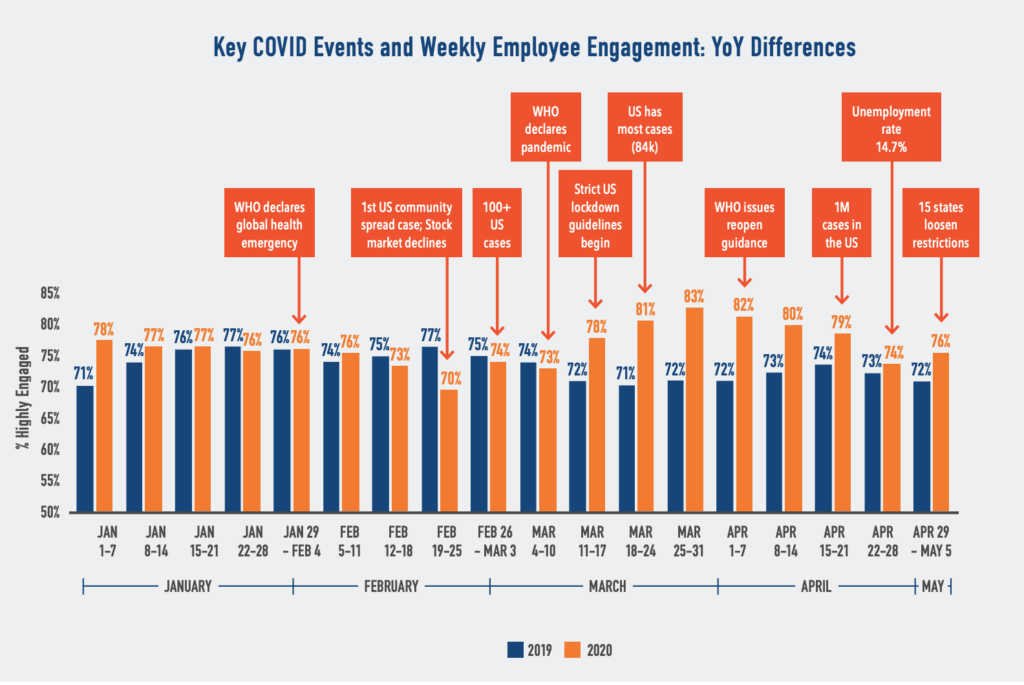Employee Engagement in the NEXT Normal

The May 2020 Gallup survey on Employee Engagement finds:
- 38% of employees are actively engaged. This is highest the metric has been since 2000 when Gallup started tracking. At that point it was 26%.
- Actively Disengaged employees (those that have miserable work experiences and spread their unhappiness to their colleagues) has remained at its lowest of 13%.

A Quantum workplace study released in June 2020 reported employee engagement at its peak in 2020 was up 11% over the same time in 2019. Coinciding with the initial negative impacts of the pandemic, engagement rose from a low of 70% in February to a high of 83% at the end of March.

As HR practitioners we have always known the value of Employee Engagement. The 2019 study on Employee Engagement conducted by GLINT finds engagement is still widely viewed as being linked to overall company performance.
- Over 90% believe there is solid evidence linking engagement to performance, and they believe it has the strongest impact on customer service and productivity.
- Highly engaged organizations are more than twice as likely to report being top financial performers in their industries.
Paired together, these findings are encouraging however, the timing makes it surprising especially since this is a metric that has been difficult to improve in the best of times.
Why the improvement? Could it be that more leaders are now practicing the behaviors that lead to increased employee engagement? And practicing them more intentionally, more regularly and with greater intensity?
Disruption is usually the catalyst for significant change. Starting with the pandemic a level of disruption most of us have not seen in our lifetime has been created. It has been the catalyst for our leaders to increase their communication, be more transparent, ask more, listen more, show concern for their employee and develop more trusting relationships.
These leadership behaviors are not new. They are the tenants of fostering employee engagement. We now have more data to support the positive impact of these leadership behaviors even in toughest of times.
Communicate – Communicate regularly and often. Communication today is not hierarchical. It goes up and down, across and sideways. Face to face may not be possible right now, but Zoom to Zoom is, whether individually or in groups. Technology and social media, continue to provide us with multiple options and as a result of remote working, employees are spending more and more time on line. Utilize as many channels as you can. Meet your employees where they are.
Be Transparent – Share as much information as possible. Sam Walton said “The more they know, the more they’ll understand. The more they understand, the more they’ll care. Once they care, there’s no stopping them. If you don’t trust your associates to know what’s going on, they’ll know you really don’t consider them partners.”
Our current world, both at work and at home have a higher level of uncertainty. Tell your employees the truth even if the truth is “you don’t know”. Our employees can handle the truth. Transparency and truth build trust. If they know you are there for them, they will be there for you and the organization.
Ask for Feedback – Ask lots of questions — not simply to your direct reports, but to frontline people, peers, other organizations; from as many sources as possible. You will usually receive some great ideas. Implement them if you can. By asking, you will let others, especially your employees know they are valued and their opinion matters.
Listen – Many times, we are so busy thinking about how we will respond in a conversation that we don’t listen as effectively as we should. We miss much of what someone is trying to tell us and it shows. Stephen Covey said it best “Seek First to Understand, Then to Be Understood.”
Harvard Business Review digs deeper into what Great Listeners do. Some of their tips include:
- Ask more questions
- Create a safe environment where open dialogue takes place
- Engage in cooperative conversations
- Make suggestions
Meaningful Work – Connect the dots for your employees. Are the company’s mission and goals shared across all levels of the organization? Do your employees know how their role connects to the achievement of those goals, to the success of the organization? Have your organization’s goals changed in the past several months? Do your employees know what those changes are?
When employees understand this connection, pride in work increases. Employees are more invested in doing a great job.
Recognize, Recognize, Recognize – In a study by Bonusly in 2019, 84% of Highly Engaged employees were recognized the last time they went above and beyond at work compared to only 25% of Actively Disengaged employees.
Recognition does not have to be expensive or glamorous. Sometimes a simple act, such as a “thank you” or “good job”, publicly or privately can have the greatest impact. Be specific and timely. What gets recognized gets repeated not just by the individual being recognized, also by other employees observing the behavior.
Involve employee peers. 44% of all workers say they will provide peer recognition on an ongoing basis.
Recognize the milestones and small wins along the way. These are just as important. They reinforce motivation and offer an opportunity to provide individual recognition as well as team recognition.
The benefits of employee engagement are many; increases in retention, employee satisfaction, customer service, productivity, sales, loyalty and trust. Our organizations need the benefits of employee engagement now more than ever. More importantly, our employees need to benefit of our change in behavior. Disruption has created the opportunity for all of us to create an engaged, NEXT normal for our employees.


Leave a Reply